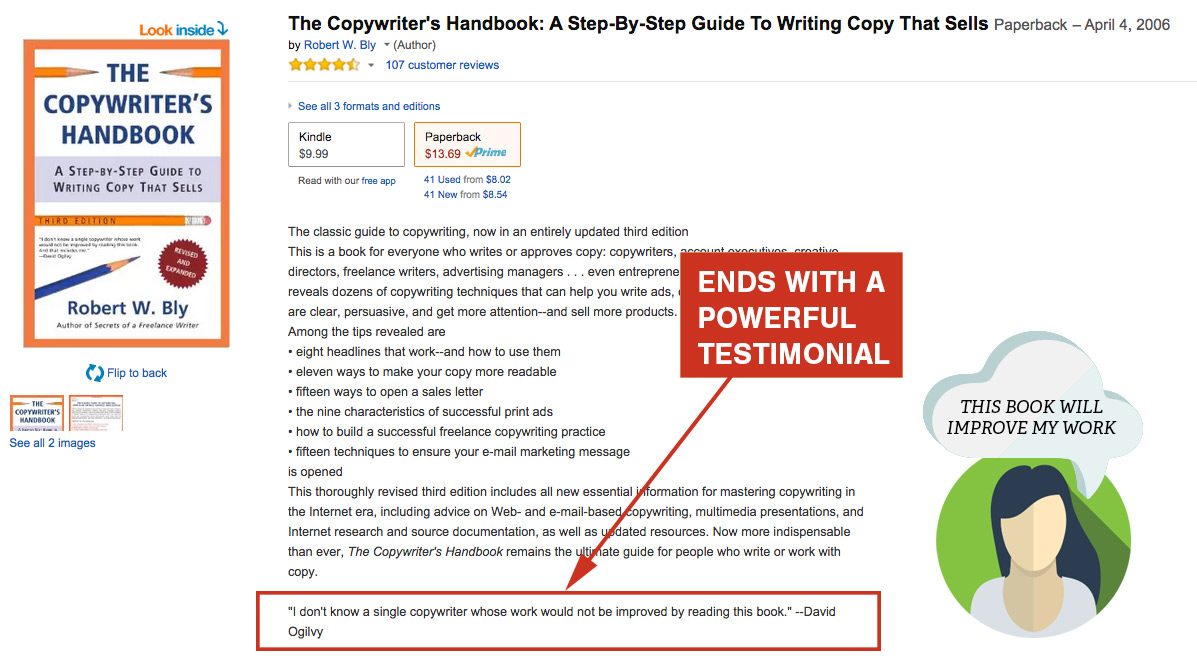People don’t read online; unless they’re about to spend money—then they scrutinize each word.
Design, SEO, and advertising can only get you so far. If you want to accelerate sales online, you need persuasive copy. According to Harvard Business professor Gerald Zaltman, 95% of our purchase decision occurs in the subconscious mind. Most marketers ignore how our brains work and fight against human psychology.
With a few persuasive writing techniques, you’ll be able to write compelling copy quickly and sell more products.
“The principles of psychology are fixed and enduring. You will never need to unlearn what you learn about them.” Claude C. Hopkins
This is a mammoth post, so I added links to sections for you TL;DRs out there.
- Use Repetition To Make Your Claims Believable
- Use Maslow To Match Search Intent
- Turn Shoppers Into Buyers With Benefit-Focused Copy
- Use Forum Research To Get Inside Your Buyers’ Mind
- Use Sensory Words To Connect With Your Buyer’s Subconscious
- Use Scarcity To Boost Sales
- Use Micro Commitments To Turn New Customers Into Big Spenders
- Use The Blemishing Effect To Increase Trust
- Amplify Your Top Pages With Power Words
- Improve Ad Performance by “Borrowing” from Tested Copy
- The Disrupt and Reframe Technique (DTR)
- Use Buyers’ Words to Build Brand Preference
- Use the Endowed Progress Effect To Build Customer Loyalty
- Sway Buyers On The Fence With A Rhyming Sequence
- Be Ultra Specific
- Use Social Influence To Lift Conversions
- Use Mini Stories to Fascinate Readers
- Improve Message Recall with The Serial Position Technique
- Use The Priming Technique to Make Your Marketing Their Idea
1. Use Repetition To Make Your Claims Believable
Repetition is one of the easiest persuasive writing techniques. The more someone hears your message, the more believable it is. This psychological concept is known as the ‘illusion of truth‘.
This technique is most effective when people are least attentive. Since the average online attention span is 8 seconds – you better be repeating your benefits throughout your product page.
Step 1: Determine The Biggest Benefit Of Your Product
Hopefully, you’ll take me up on Tip 3 and create a feature/benefit list for your product. If not, don’t overthink it. Go for the most obvious benefit.
The most obvious benefit for a jacket is weather resistance.
Step 2: Repeat The Biggest Benefit 3-5 Times
Most people will scan first before reading. So make sure you include your #1 benefit throughout your page layout. Include it in your headline, intro, subheads, bullet points and conclusion.
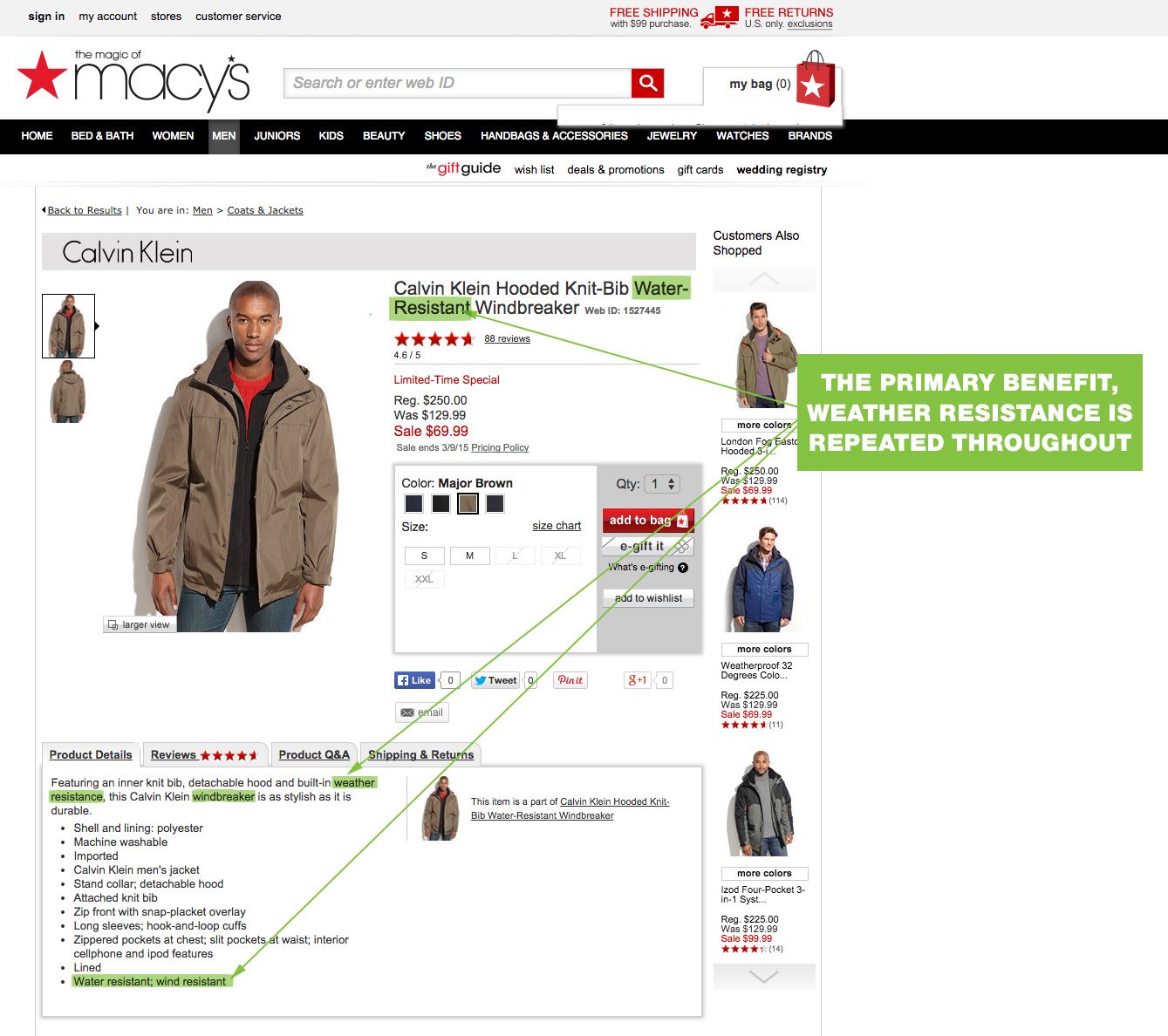
Take a look at this Calvin Klein jacket. Macy’s wants you to believe this jacket is weather-resistant. The product page gets the point across, without mind-numbing repetition.
2. Use Maslow To Match Search Intent
Remember Maslow’s hierarchy of needs from college? Maybe you forgot because you didnt get enough good sleep. Every time your prospect uses Google search it’s out of a deep psychological desire.

Your job as a marketer is to understand that need. Your copy will be much more persuasive, and it will rank significantly better in a Google search.
Step 1: Determine The Psychological Need Of Your Product
Your job here is to address the primary psychological need behind a search for your product. Some products can meet two. But we want to keep it simple and actionable, so pick one.
- Are you selling make-up or jewelry? Esteem.
- Are you selling organic food? Physiological.
- Are you selling antivirus software? Safety and security.
Step 2: Use Words Suited For That Mental State
Tone matters a lot in writing. Once you are through with step 1, add some words from this article to your product page.
Step 3: Anticipate Questions About Your Product
Use the keyword research to find questions about your products. This will help you match search intent from a potential customer.
- Plug Your Product Page Into Google Keyword Planner
- Include When, Where, Why, What and How As Required Words
- Look for Concerns You Can Address On Your Product Page

Your goal with step three is to find concerns related to your product that you can address on your product page. If you still can’t find real product questions try this Twitter research trick from Ann Smarty.
Step 4: Connect Questions to Product Features
Some shoppers might be concerned about cleaning a leather jacket before buying. Your sales page should briefly address that concern. The solution is easy. Add a simple bullet that turns the question into a benefit.
Ex: “Top-grain leather that cleans easily with a microfiber cloth.”
Your updated page meets psychological, emotional needs and overcomes objections a buyer might have. Sounds like a slam dunk to me. 🙂
3. Turn Shoppers Into Buyers With Benefit-Focused Copy
No matter what product you are selling, the benefit to your customer is a better version of themselves. This is why it is so important to understand who your ideal customer is, what questions they have, and how you can help them. You’ll be wasting your time if you jam persuasive tricks into your copy. Even worse, you might come off like a manipulative idiot.
Here is a 3-step process to write benefits-focused, persuasive copy.
- Make a list of your product features.
- List actual benefits of using the product.
- List out how those benefits make your customer’s life better OR avoid problems.
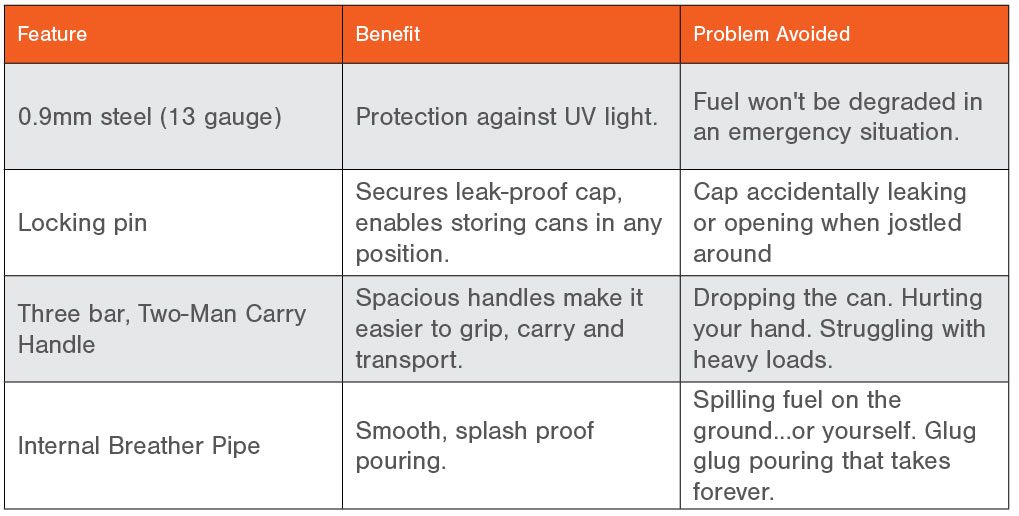
Henneke Duistermaat has an entire ebook that goes into more depth about writing benefits-focused sales copy. You can grab a copy .
4. Use Forum Research To Get Inside Your Buyers’ Mind
Would you be able to sell more products if you knew someone’s thoughts before they buy something? Of course you would!
You don’t have to do exhaustive primary research to find the right words to use, but you do you need to find out why people buy your product and use that language on your product or category page. Here’s how:
Step 1: Find Conversations about Buying Your Product
There is an online forum for just about any topic. A lot of times you, can find people who just bought a similar product, and you can see who they are and what they are chatting about. Type the following searches into Google. Just replace “keyword” with your product and “niche” with your industry.
- “keyword” OR “niche” “just bought” inurl:forum
- “keyword” OR “niche” “should I buy” inurl:forum
- “keyword” OR “niche” “should i buy” “because” inurl:forum
- “keyword”OR “niche” “just bought” “because” inurl:forum
- “need help with” “keyword” OR “niche”
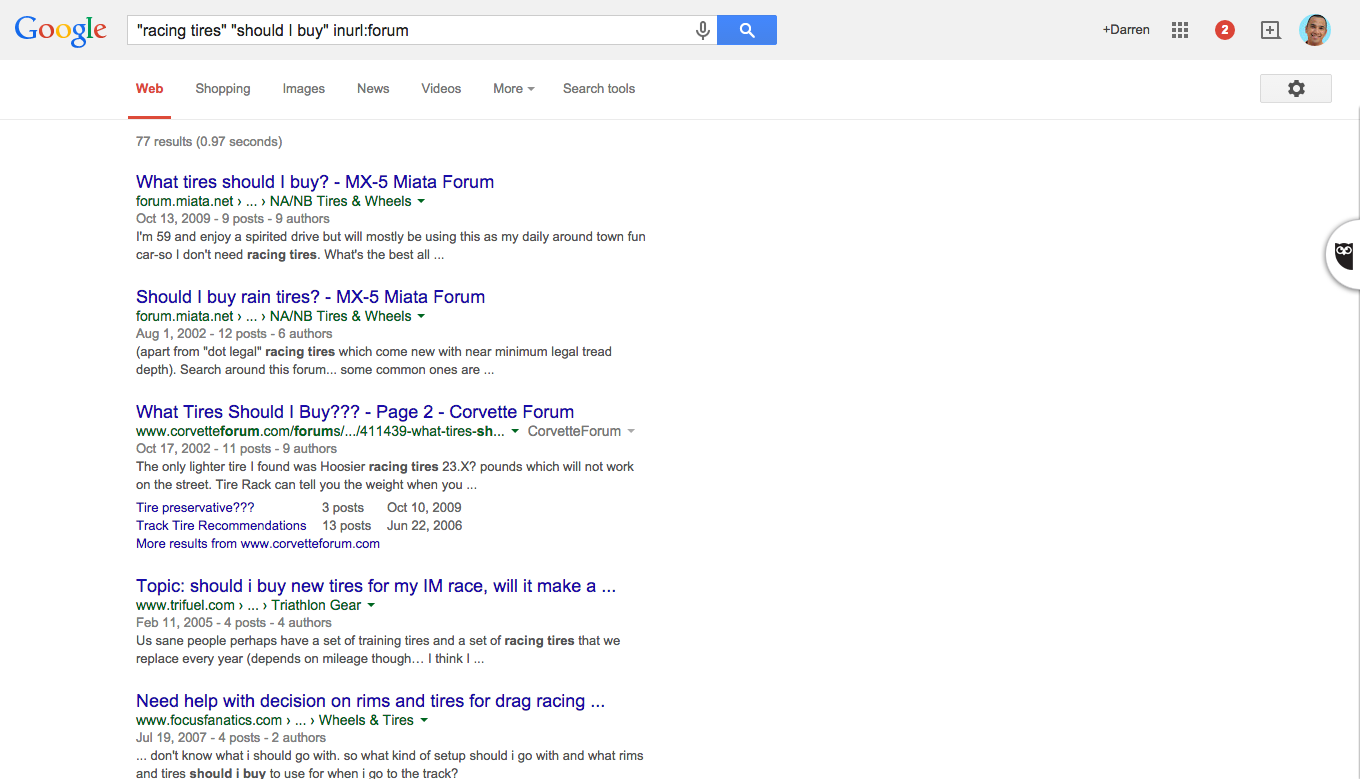
The search term, “racing tires” “should I buy” inurl:forum surfaced 455 car enthusiasts talking about buying racing tires. This is like eavesdropping on a conversation between friends. No focus group needed. How’s that for marketing research?!
Step 2: Read The Threads and Create a Quick and Dirty Persona
In this step, your goal is to create one (yes, only one) buyer persona.
- Open up a forum thread from Google search.
- Click on a commenter’s profile link.
If you can’t find info about their age, location, hobbies and profession take an educated guess. Your persona should also have a name.
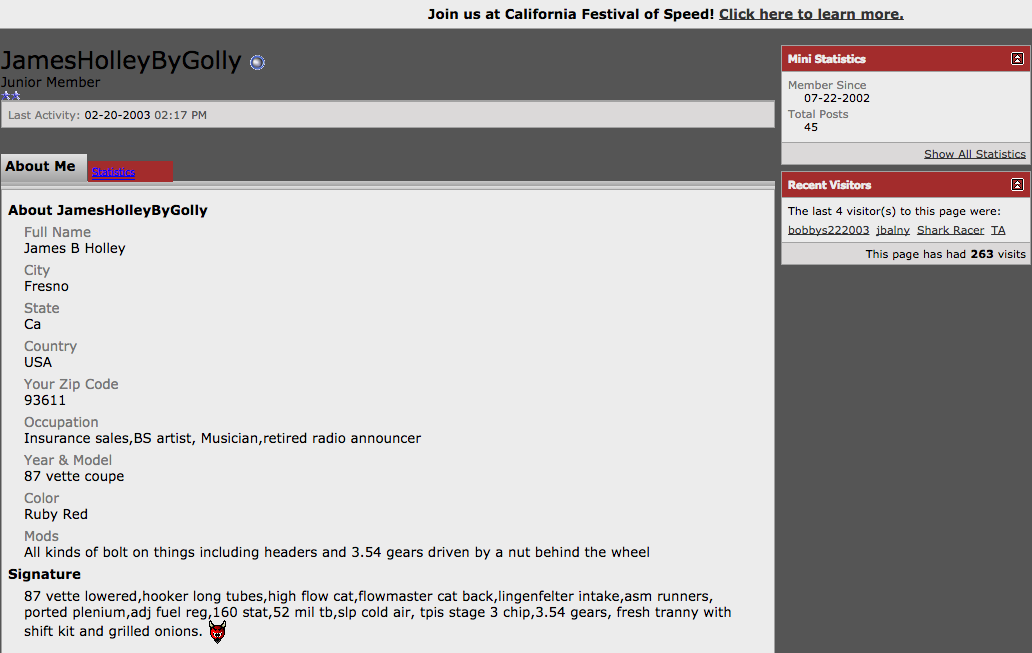
Step 3: Collect Answers To The 5 Questions Below:
As you research the forum threads copy and paste answers to these questions.
- Why did they buy?
- What are their pain points?
- What concerns did they have before buying?
- What is important to them when buying this product?
- What do they use the product for?
Step 4: Update Your Pages
It’s easy to forget that you are writing for a person when writing on the web. Understanding the mental state of potential buyers is the most powerful market research you’ll ever do. As you update your product pages, keep James Holley in mind. He is probably anxious to burn some rubber after a long week selling insurance.
5. Use Sensory Words To Connect With Your Buyer’s Subconscious
I’m not talking about fluffing your copy up with phony adjectives. Meaningless words like “high quality” or “state of the art” send your reader’s brain into glazed state. Sensory words describe and create a feeling.
Our subconscious collects sensory data (taste, smell, sight, hearing, touch). When information is registered, sensory areas of the brain are activated.
Step 1: Observe Your Product And Create A List Of Concrete Words
Create a table in Excel with sound, sight, touch, smell and taste as headers. Observe the sensory details of your product. Don’t overthink this. If you can’t imagine it, it is not concrete. You don’t need to appeal to all five senses, and you don’t need a mega list.
After two minutes of examining the Crocs on my feet, I came up with these sensory words. Not brilliant, but it’s a start.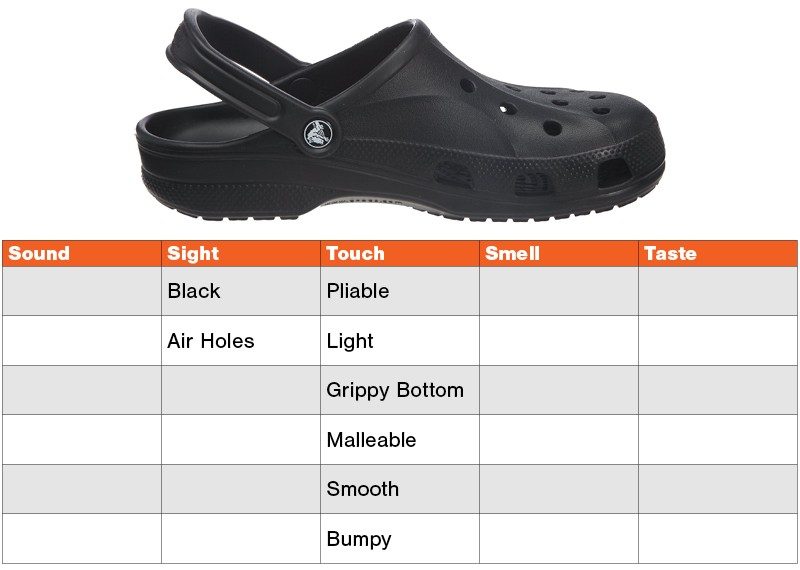
Step 2: Read Customer Reviews To Find Sensory Words
In this step, you are looking for words that describe your product and the environment of how it’s used. While reading reviews, I noticed people use Crocs at the beach and inside their house.
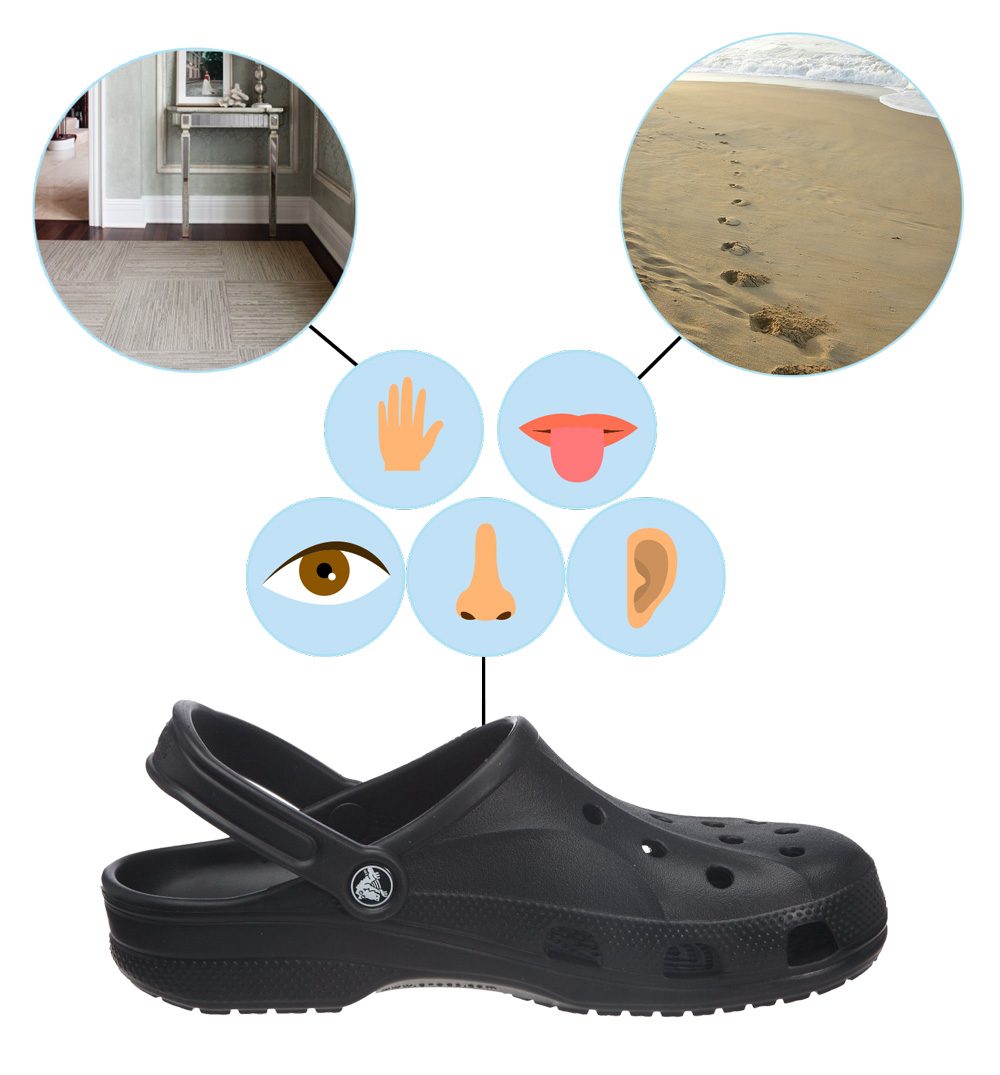
You don’t have to make this a grind. To combat information overload, sort the reviews by most helpful. Spend a few minutes on this step, no more. After reading the first two pages of product reviews, you’ll be able to add some words that you hadn’t thought of.
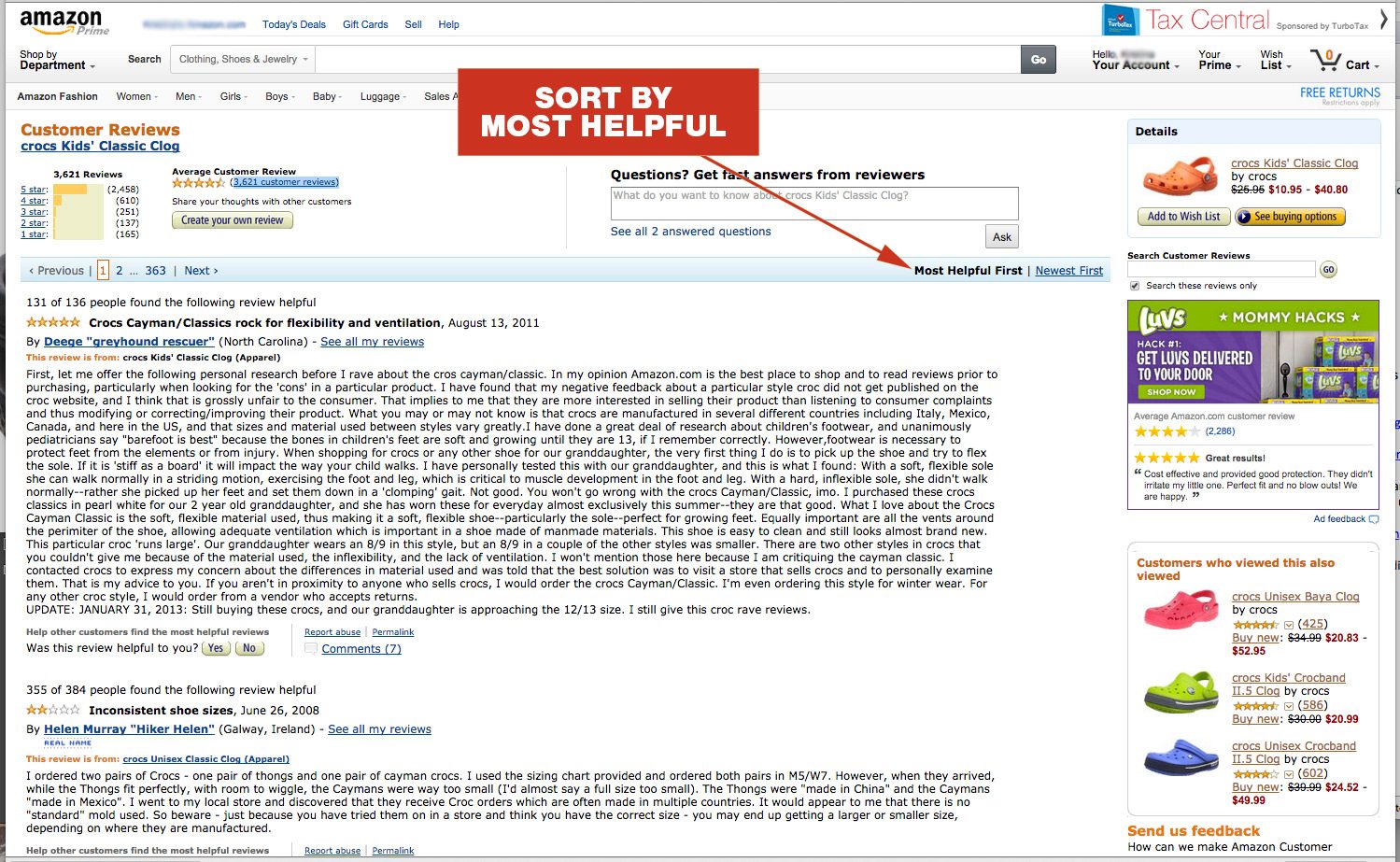
Step 3: Add Sensory Words To Your Product Description
When you tackle this step, give context to the words you use. For example, “blisters” is a very concrete, sensory word, but it is also negative. So your copy could say “A flexible sole helps avoid foot pain and blisters from walking on hard tile floors.”
Compare our quickly crafted sentence with Kohl’s product description: “Crocs shoes are great for outdoor adventures.” (Yawn). No one buying shoes is looking for an “outdoor adventure.”

6. Use Scarcity To Boost Sales
Cialdini’s principle of scarcity states that desire to obtain something increases when there is a perception of limited availability. Research shows that scarcity increases impulse buying.
Don’t burn bridges like CoffeForLess with fake scarcity. Use this technique when you actually have a limited time offer or limited quantity.
Step 1: Create A Time Sensitive Sale
Select high margin or popular products. Install a countdown timer plugin, email your list and run a sale. There are a lot of plugins that can do this. Here are a few of them:
- Sales Countdown For Woo Commerce
- Sales Countdown For Open Cart
- Price Countdown For Adobe Commerce
- Page Expiration Robot – Countdown Timer For WordPress
- Shopify Countdown Timer

Step 2: Add A Limited Quantity Alert On Product Pages
Use a plugin to show visitors a message when your inventory is low. Phrases like “Hurry! Only 1 left!” can help move customers to action. People get a thrill when they snag the last one. I know I do 🙂
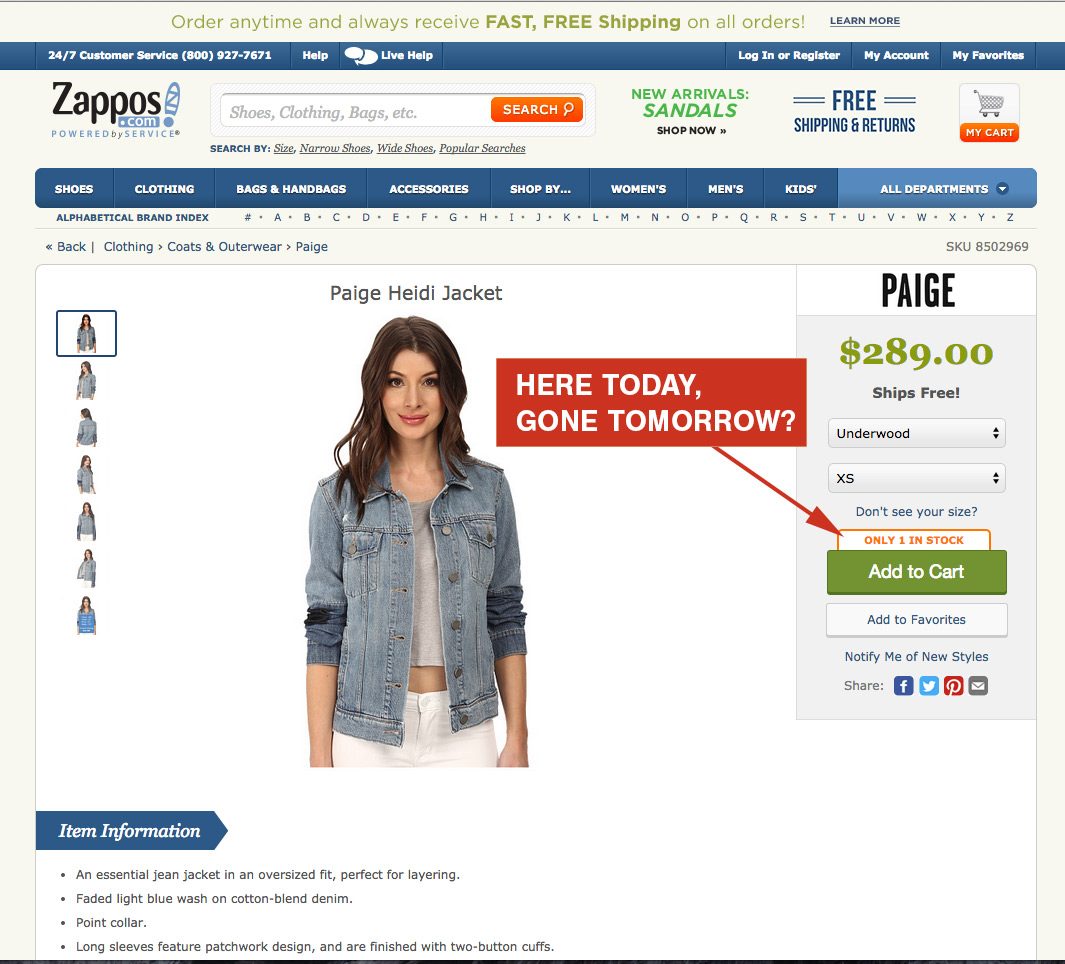
Never pressure people to PUSH them into purchasing. Instead, use pressure to PREVENT them from procrastinating. There is a fundamental difference between the two. – Michel Fortin
Thinking about using scarcity tactics on your product page? Check out this in-depth article and be sure to take a non-scuzzy approach.
7. Use Micro Commitments To Turn New Customers Into Big Spenders
A high dollar sale on the first visit can be a big ask. Instead, use the principle of commitment and consistency. People want to be consistent. Once someone commits to something small, they are more inclined to continue the process.
How can you use this to increase sales?
Step 1: Ask New Customers if They Are Likely to Buy from You Again
Customers love getting an order confirmation emailed to them. Turn it into a marketing opportunity. Use automated email software like Klaviyo to add this question to the bottom of the order confirmation email:
“Are you likely to buy from us again? Yes No.”
Make the responses “Yes” or “No” hyperlinks so you can track if they are clicked. You don’t want to set up a complicated survey, work it into your regular workflow and make it as easy as possible.
Step 2: Send a Coupon/Promo Code
Customers who responded positively to your first email are likely to follow through with their original commitment. Incentivize them to be consistent by sending them a coupon to save $10 when they spend $150. The actual numbers will depend on your store. The goal is to turn them into a big spender.
You can even word the email like this:
A few weeks ago you said you would like to buy again from mystore.com. We wanted to send you a quick thanks for your recent order with a promo code to save on your next purchase. You can save $10 when you spend $150. Here are some of our most popular items (show images of products over $150). Promo code is good for 30 days.
When someone publicly declares they will do something, they are likely to carry through with that statement. This is also called the “mere-measurement effect.”
Tip: Send the same email to people who also said no. Just remove the first sentence.
8. Use The Blemishing Effect To Increase Trust
Trying to hide the negative features of your product? Researchers from Stanford suggests you shouldn’t.
Customers can tell when you write a product description that’s 100% positive fluff. Adding in a small dose of negativity can make your product more attractive.
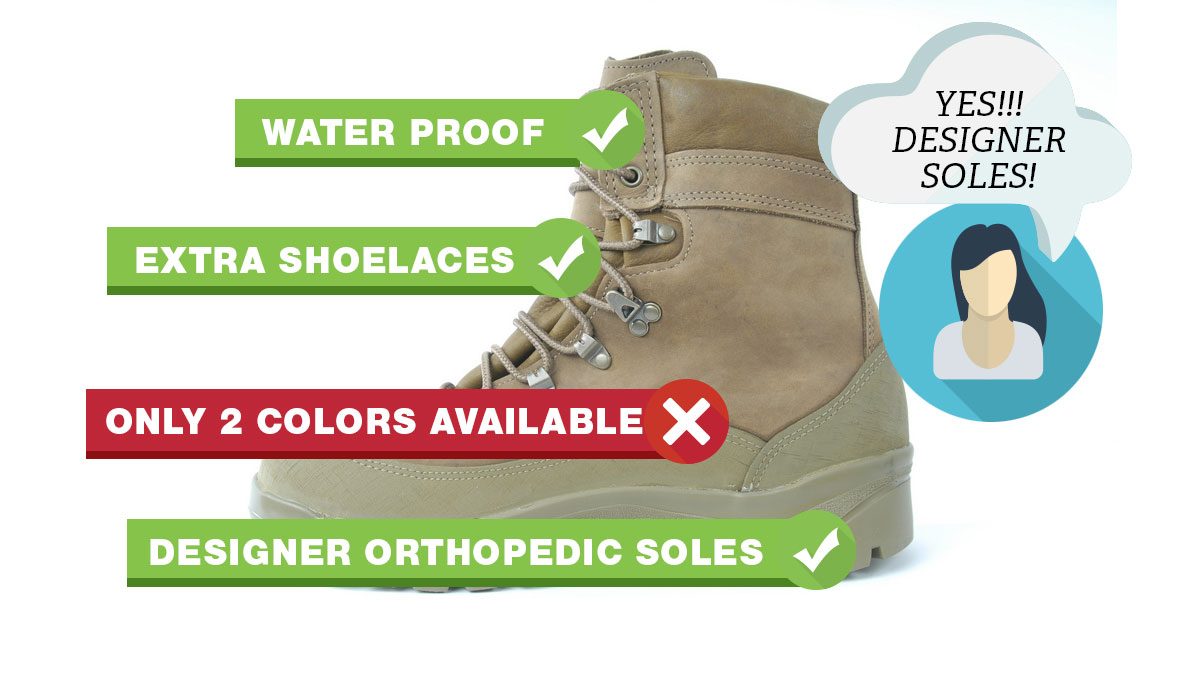
We find that as long as the negative information about a product is minor, your pitch [to a consumer] might be more persuasive when it calls attention to that negative, especially if consumers have already learned some positive things,” –Baba Shiv
9. Amplify Your Top Pages With Power Words
A lot has been written about the psychology behind persuasive words. Here are “must have” words for your ecommerce site.
- You: Using this word forces you to focus on how customers will benefit from doing business with you.
- Free: Our brains are hardwired to respond to “FREE.” Don’t overdo it.
- Because: Giving your reader a reason will make your copy more persuasive. Using because helps you trigger action by giving them a specific reason.
- Imagine: Research suggests that imagining using or owning a product increases the desire to own it.
- New: Using this word activates the brain’s reward center and makes products seem more attractive.
Now that you know the words to use, it is time to put them to work for you.
Step 1: Use Google Analytics to Find Your Top Landing Pages
Don’t try to update all your pages at once. It is too tall of a task. Use Google Analytics to find your top 3-5 product landing pages.
- Log in to Google Analytics
- Click on Behavior
- Click on Site Content
- Click on Landing Pages

Step 2: Update the Copy To Include Those Power Words
Chances are your home page is a top landing page. Be sure to include power words, like “Free Shipping” in global elements like headers.
Use power words at the beginning and end of your product page. Include them in bulleted lists too.
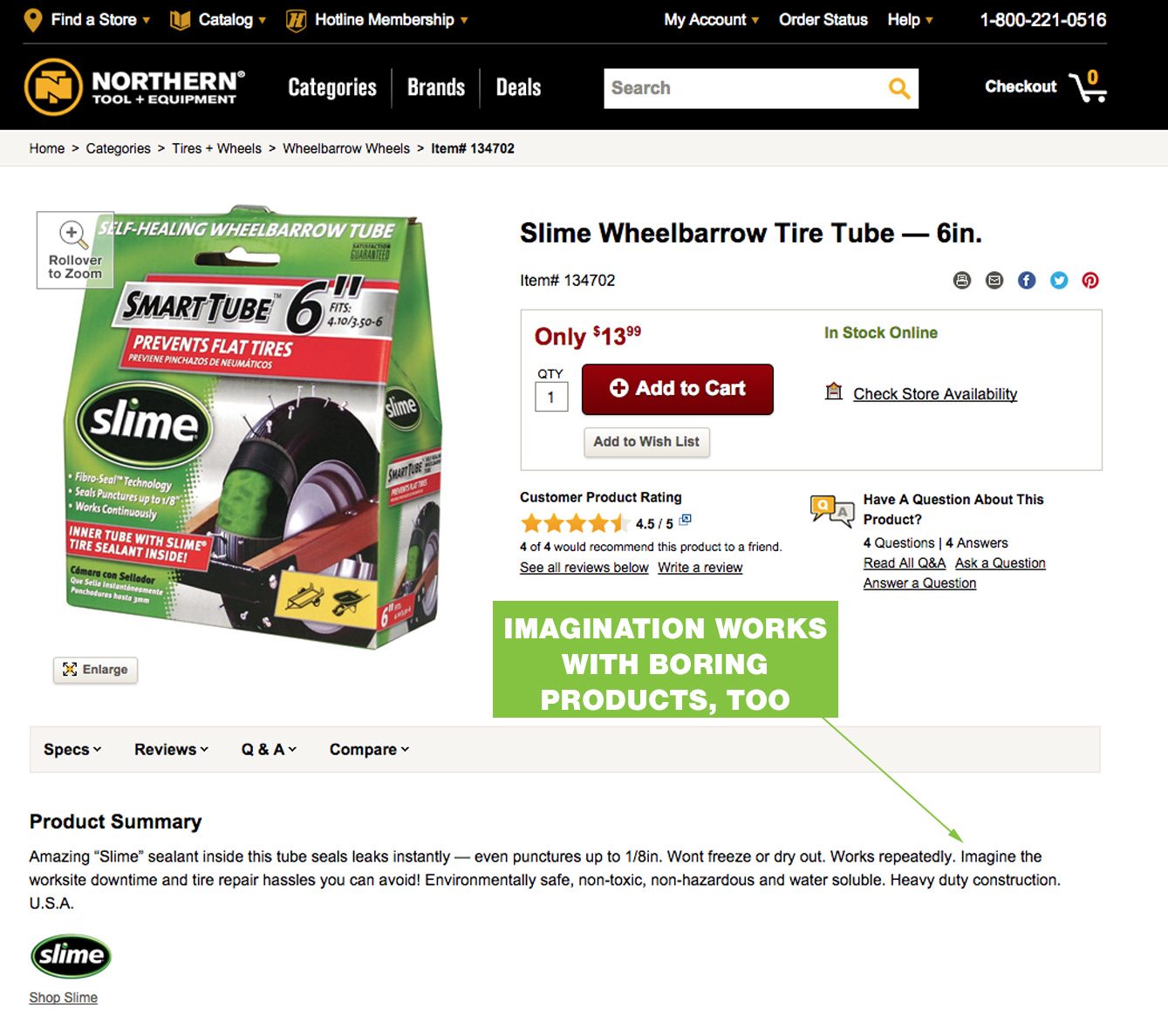
10. Improve Ad Performance by “Borrowing” from Tested Copy
When you’re writing persuasive copy, it’s easy to miss the forest for the trees. If you don’t analyze competitor ad copy, you’re missing out on insights from tested copy.
Step 1: Find Out Who The Big Advertisers Are In Your Niche
Type a keyword from your niche into SEMRush along with (adwords_historical). In the example below, I used “work boots” (adwords_historical) to see all the companies advertising for that keyword. Look at their ads traffic price to get an idea of how much they are spending each month.
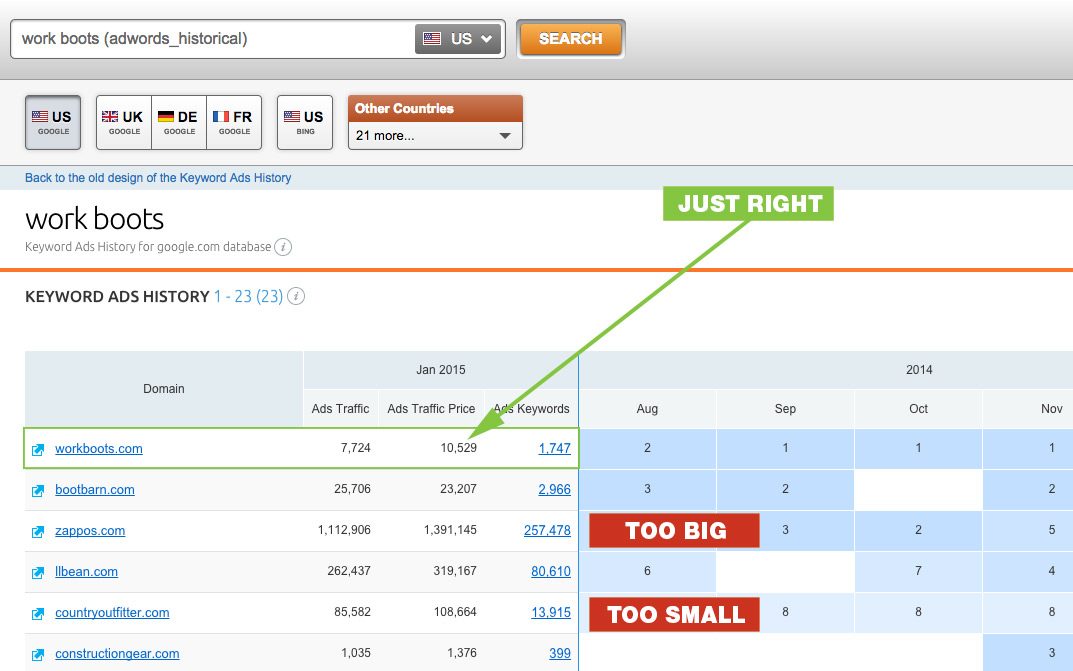
Stick with companies spending more than $10K per month. These companies are smart enough to test their ads and use the best performing ads the most. Avoid megastores like Amazon or Overstock.com. You’ll get too much data to analyze. You want to write persuasive copy, not analyze data.
Step 2: Review Their Ad Copy
In SEMRush type in the big spenders domain with (by uniq_ads) to see all of their ads. In the example below, I typed in workboots.com (by uniq_ads). SEMRush will show you the ads that have the most keywords. For a company spending $10K + on PPC, you can bet that their best ads get the most keywords. Look for common themes within the ads. Pay extra attention to any benefit-focused ads.
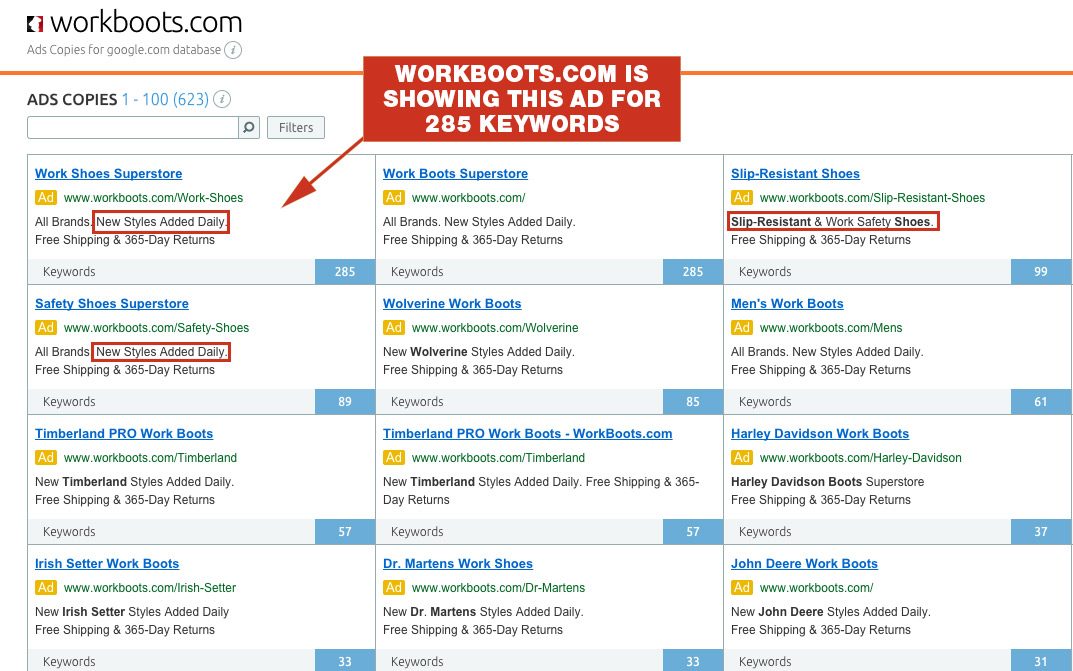
Step 3: Update Your Copy
Your competitors spend a boatload of cash figuring out which ads sell the most products. People who shop for work boots care about new styles and slip resistance. Focus on those points when updating your copy. Also consider following these copywriting tips.
11. The Disrupt and Reframe Technique (DTR)
If you want a fast and effective method for influencing people, DTR is it.
Most of us go into auto-pilot mode when surfing the web. By disrupting your readers’ understanding on a typical phrase, you can knock them out of auto-pilot and reframe their thought process to give new meaning to the confusing phrase.
Apple’s entire marketing strategy is based on DTR.

Here is how you can do it:
- Add a bizarre or confusing statement in your copy: “Retina re-envisioned”
- Reframe it to give new meaning: “The moment you open the new MacBook, its gorgeous 12‑inch Retina display with edge-to-edge glass brings everything into focus. Every photo leaps off the screen in rich, vibrant detail.”
12. Use Buyers’ Words to Build Brand Preference
Have you ever bought a product because your friend told you it was “high performance” or “innovative”? No.
This is why you need to eliminate marketing speak and write for your ideal buyer.
Professional copywriters know that the most persuasive language comes directly from the customer (see Tip #28). But why?
According to the Kellogg Marketing Faculty at Northwestern University, consumers seek comfort and self-expression in the brands they choose. By using your customers’ own words you can shortcut the persuasive writing process and help readers self-identify. Joanna Wiebe explains how to do this in her post, but here is the gist:
- Search for customer reviews for your product on Google, Amazon or forums.
- Copy memorable phrases directly from customers.
- Paste them into your product pages.
Don’t copy entire paragraphs. You’re looking for emotionally charged phrases to leverage into your copy. Here are some examples from racing tires:
- “quicker acceleration, better braking, smoother ride, less wear on shocks”
- “Lower weight is important, but traction is more important”
- “meaner tire, they have great wet traction, they stick, lots of dry traction”
- “Some people whine about them on wet roads, but I had zero hydroplaning issues and I drove them through winter here in the metroplex”
- “with fresh rubber”
- “I love spirited driving”
You want to sound like a customer, not a marketing company. Check out some more examples here.
13. Use the Endowed Progress Effect To Build Customer Loyalty
You’ve worked super hard to get a customer, use the endowed progress effect to keep them buying from you.
Reward programs give your customers a sense that they are working towards a goal. By giving them a few extra free points, they will be more likely to buy from you again. Check out this study from USC.
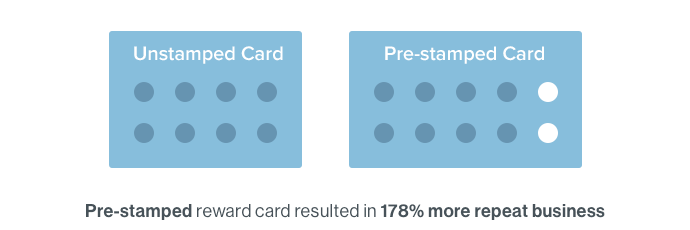
To create an effective program you need:
- Reward program technology. Like a plugin or points system.
- A persuasive autoresponder email chain to let customers know they’re close to a reward.
Please don’t just use the boilerplate copy from the plugin. Be sure to cater it to your audience.
14. Sway Buyers On The Fence With A Rhyming Sequence
Research suggests that rhyming phrases are more believable. I am not suggesting that your product pages sound like nursery rhymes, but the “rhyme as reason” effect can help persuade people who are on the fence.
Johnny Cochran, O.J. Simpson’s lawyer, knew about this cognitive bias.
If the glove does not fit, you must acquit.
Rhyming makes copy easier to remember and ideas easier to digest. This concept is also known as the fluency effect. Rand Fishkin has an excellent white board on this topic.
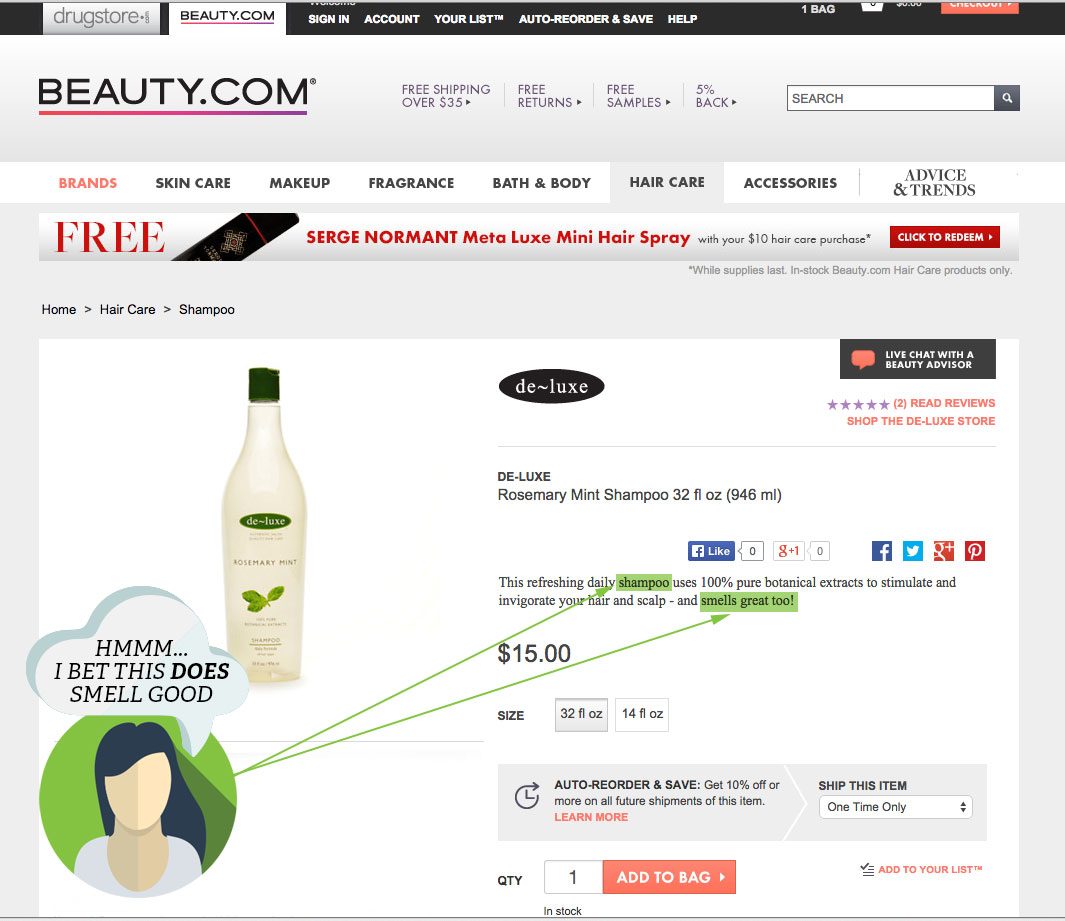
Here is how you can incorporate rhyming today:
- Boil your product or benefit down to the simplest word (ex. Weather Proof Jacket = rain)
- Go to Rhymer.com
- Find a word that rhymes with your product or benefit (ex. main)
- Add the rhyming phrase to the start or end of your product description (ex. The Calvin Klein hooded windbreaker will be your main jacket to project against the rain.)
This exercise can be a lot of fun, and it will make your benefits more persuasive. Don’t overdo it, Mother Goose.
15. Be Ultra Specific
Copy has to be credible to be persuasive. We are all bombarded with generic marketing claims all day long. Precise details turn your ho-hum headlines, taglines and slogans into believable messages.
When it comes to selling products, details about problems or benefits make your copy trustworthy. Notice how the details describe the benefits of the raincoat material.
Constructed with durable, water-resistant, urethane-coated nylon taffeta and rustproof snaps; watertight bound seam construction. – REI
Ask yourself these questions to help you pull out the relevant details for your product page:
- What is your product made of?
- Where is your product made?
- How is your product made?
- How many people have used it?
- Are there quantifiable features?
- Are size dimensions relevant?

When you start adding irrelevant details like the number of grooves on a pen grip, you’ve gone way too far.
Online shoppers are skeptical. Adding details helps people understand you are telling the truth.
16. Use Social Influence To Lift Conversions
As we saw in Maslow’s pyramid, belonging is a basic psychological need. This is why peer pressure works. Our ideas are validated when similar people share them: this is especially true for shopping online.
Here are two surefire ways you can use social influence on your ecommerce site:
1. Add Product Reviews
Reviews help validate your claims. It is one thing for you to say “This backpack is durable.” It’s more impactful when a customer says the same thing. By simply adding a reviews widget, Express Watches increased conversions by 58%.
It is not enough to add a widget; you have to be proactive about getting them. Once you add the widget:
- Email customers who purchased your top selling products
- Offer them a discount or points for leaving a review
- Add an automated email asking people for a review a few weeks after receiving the products
2. Add a Recommended Products Widget
When people get stuck on a decision, they look to see what other people do. This is why a recommended products widget can help lift conversions. When people don’t find what they want, they leave. Providing additional suggestions to them might persuade them to check out other products.
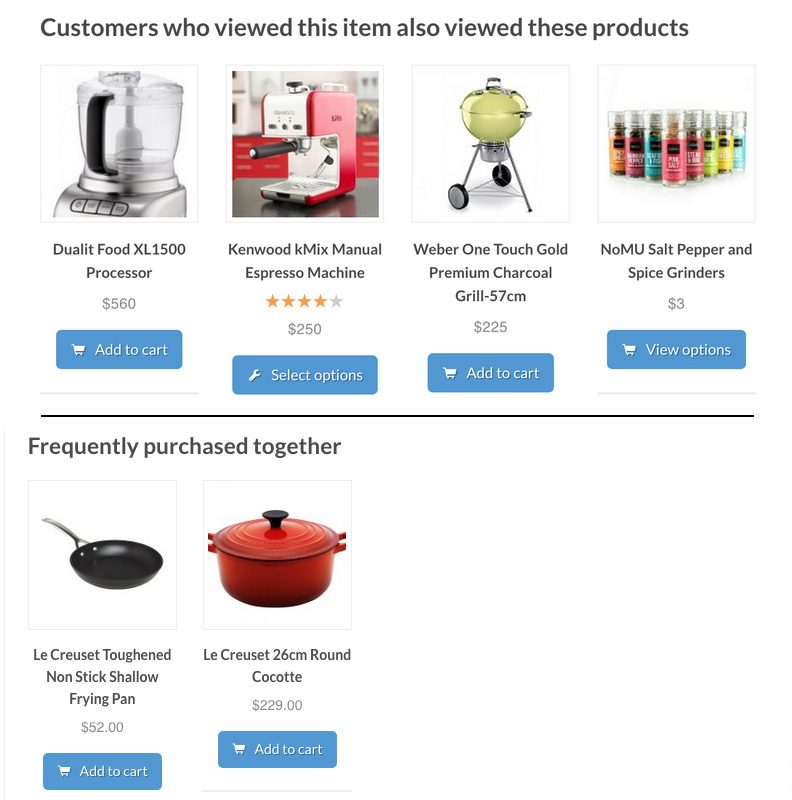
17. Use Mini Stories to Fascinate Readers
Stories that relate to your audience strengthen your brand position. If your story doesn’t, your copy will come off cheesy.
Do you remember James Holley from Tip #4? He will probably appreciate a mini story about peeling out in the office parking lot on a Friday night. This story works because it’s:
- Relevant to our ideal buyer and product
- Simple and concise
- Imagery is concrete and vivid
This mini-story would be a huge turnoff to Donna, 57, in New York City. She values safety and style when buying luxury tires. Burning rubber would run her off your site. You’re job is to tell an unexpected story that will entertain your ideal customer. Something they won’t read on an Amazon product description.
Retailer J. Peterman is known for their unique product descriptions. Check out this one.
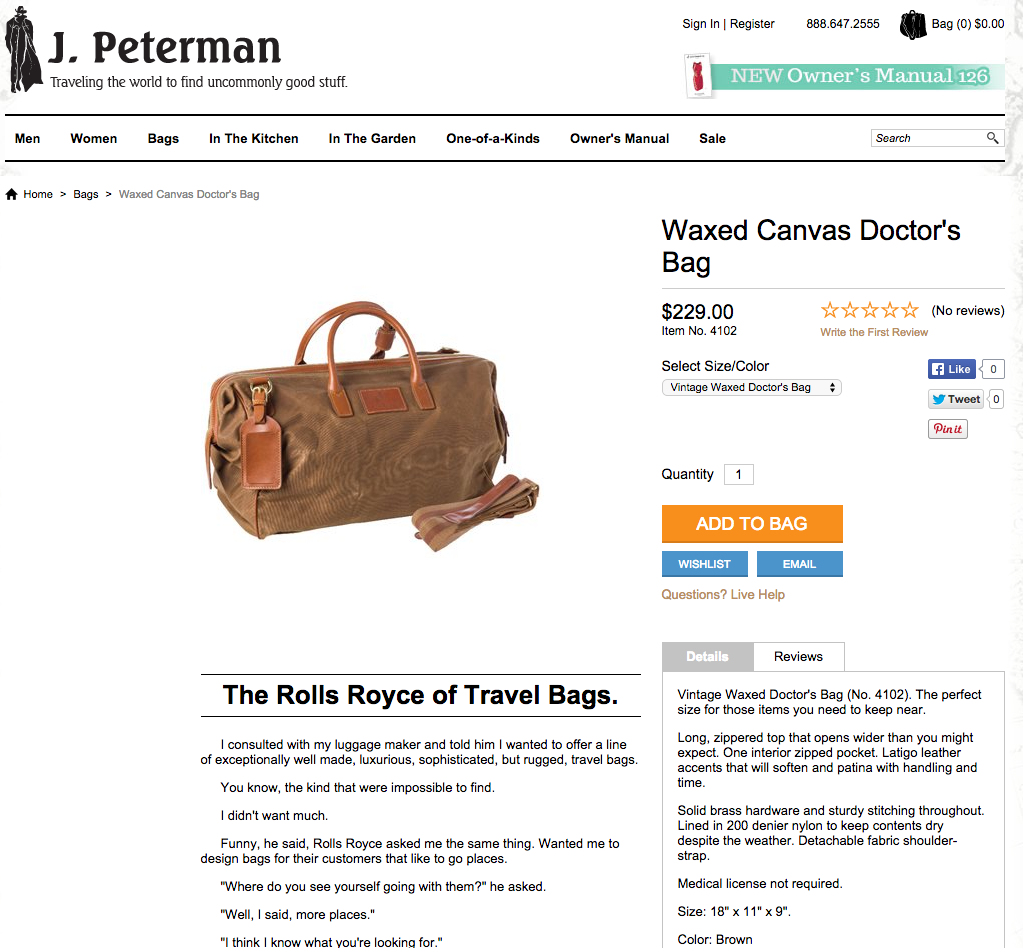
18. Improve Message Recall with The Serial Position Technique
People remember what they saw first (primacy effect) or last (recency effect). Use this to your advantage. Put your best copy where it matters most.

Step 1: Begin with an Ultra Short, Benefit-Rich Product Summary
When you write copy for product pages, you have to consider the design. Once you see how the information is layered on the page, make sure to put your most persuasive copy right at the beginning. Keep it short and uncluttered.
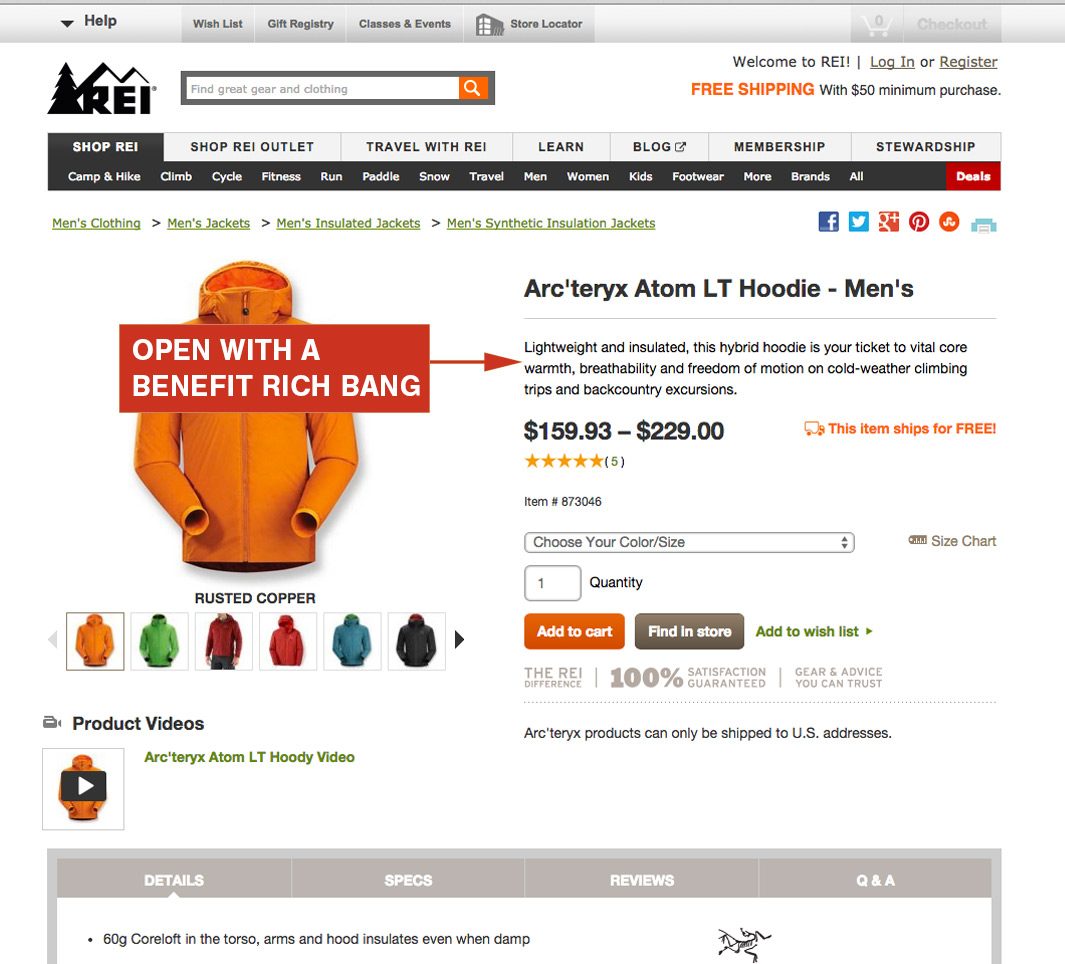
Bonus SEO tip: Use your, ultra-short persuasive intro as the meta description to improve your click-through rate from searches.
Step 2: Rearrange Your Bullets
Readers love bullet points. Don’t rattle off a bunch of product features. Make sure that your bullets are a list of benefits. Give extra love to the first and last two bullets.
Step 3: End Your Product Description with a Persuasive Message
If someone reads your entire product description, chances are they are almost ready to buy. Don’t fizzle out at the end. Give them one simple, memorable reason why they should buy this product.
19. Use The Priming Technique to Make Your Marketing Their Idea
Priming is similar to the principle of commitment and consistency Both are used to influence subsequent behavior. The main difference is that priming is the process of tapping into the subconscious mind.
Numerous studies show the priming effect in action. For example, three groups were primed with different words (rude, polite, and neutral). The group shown rude words were most likely to interrupt the interviewer. In another study, people who were shown sad faces 🙁 preferred mood-enhancing content.

Because people are influenced subconsciously, primes are perceived to be their own ideas. Remember the movie Inception? Same thing. When people think they are being “marketed to”, all bets are off.
Here are two ways you can use priming for your ecommerce site:
- Use homonyms to influence buying
- Use price priming to position your best products
Using Homonyms To Influence Purchase Behavior
A study from the University of Miami revealed that adding the words “bye-bye” in the web copy increased sales. This is because the word sounds like “buy.” You can use this on your product pages easily by using a sentence formula: “Say bye-bye to [problem] with [feature] that [benefit].”
Fuel can example: Say bye-bye to spilled gas with the locking nozzle that won’t leak.
As University of Chicago points out, you can also say “Good-Bye” on your order confirmation page to subconsciously influence that a “good buy” was made.
Don’t go overboard. If you use this on every page, it will lose its effect.
Using Price Priming To Sell More of Your Popular Products
This is not really a “copy writing” technique, but it can improve your sales. You can influence customers’ value perception by placing your top products next to super expensive products.
A $600 watch seems less expensive when placed next to a $2500 watch. This subconsciously influences your visitor to think the $600 watch isn’t that expensive. This is the reason why the default price setting on many ecommerce sites is “high to low.”
Another strategy is to implement a “featured” area on your category page.
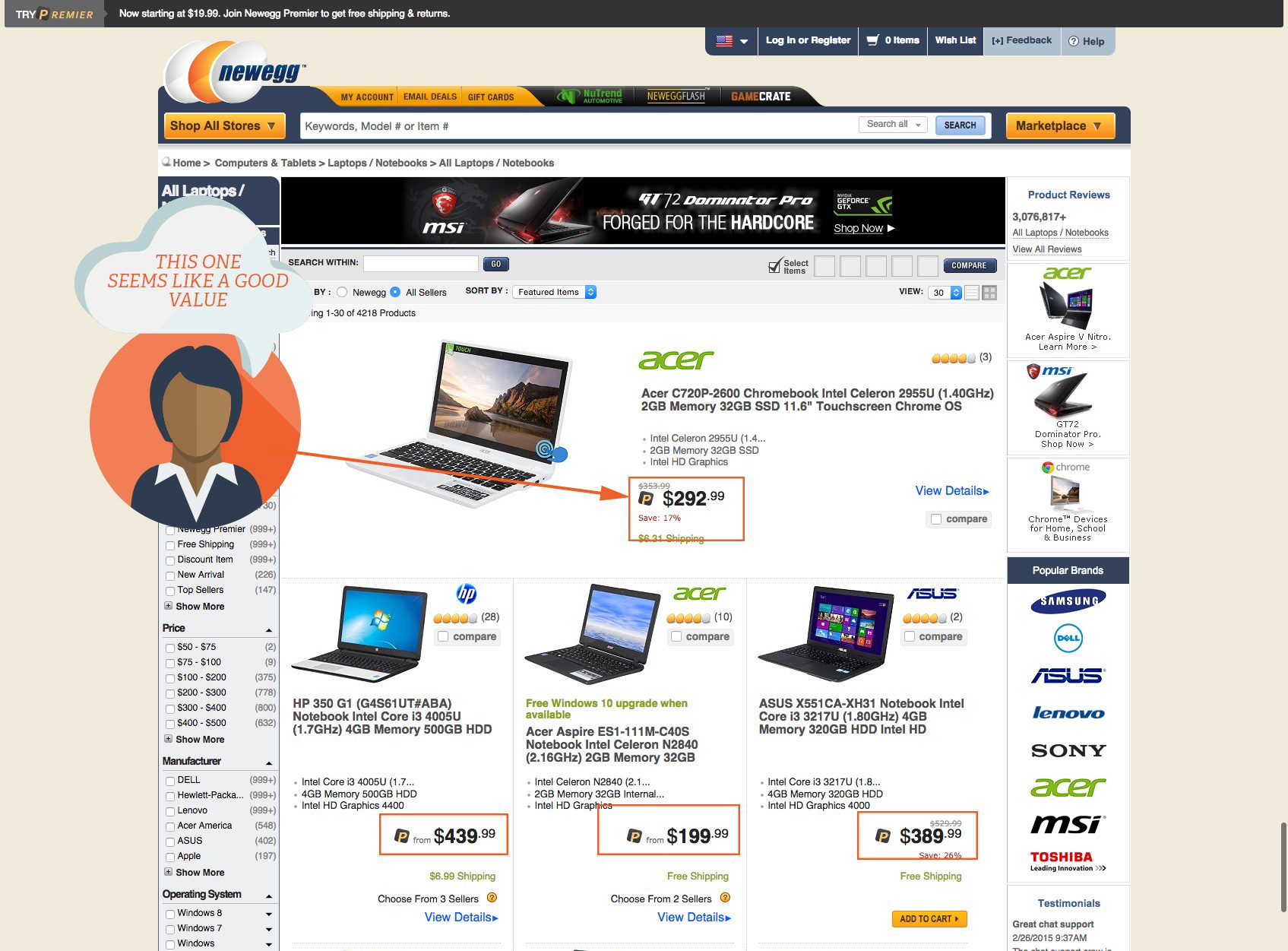
You can also use colors, images, and metaphors for priming.
Ready for More Sales?
Persuasive writing means marketing to the subconscious. This is where purchase decisions are made. We’ve gone through a long list of persuasive writing techniques. You don’t have to tackle them all at once. Pick one technique, and you’ll be on your way to improving product sales. Remember, moderation is key.
Enjoy this article? You’ll love my free ecommerce marketing course.
